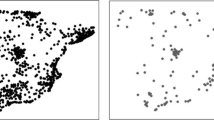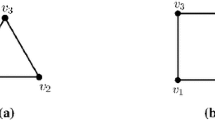Abstract
In order to mitigate the effects of the contraction in demand during economic crises, firms face the need to reduce the number of facilities in their networks. This reduction must be conducted taking into consideration both the possible actions of their rival firms and the reaction of the affected customers, so that the loss of market share is minimised. In this article, we analyse the facility closing problem of two firms operating in a duopolistic market. The problem is modelled as a non-cooperative game over a binary integer programming formulation of the firms’ delocation problem. The possible outcome of the game is analysed for three different competitive scenarios: Myopic behaviour, Cournot conjectures, and Stackelberg strategies. These scenarios are analysed under the assumption that customers show certain level of loyalty to the firm that they initially resorted to. This assumption entitles us to establish the existence of Nash equilibria in the delocation game by means of the introduction of a social planner. Moreover, this social planner provides a mechanism for computing the Nash equilibrium in the Cournot delocation game. Additionally, we develop an algorithmic approach that provides a simple mechanism for finding equilibria under Stackelberg strategies. Experimental results indicate that for small reductions in the network size the solution under myopic behaviour is often an equilibrium. For large reductions, evidence has been found that there is a first mover advantage in the Stackelberg delocation game.

Source: Instituto Nacional de Estadística, Spain


Similar content being viewed by others
References
Ashtiani, M. G., Makui, A., & Ramezanian, R. (2013). A robust model for a leader-follower competitive facility location pro blem in a discrete space. Applied Mathematical Modelling, 37, 62–71.
Benati, S., & Hansen, P. (2002). The maximum capture problem with random utilities: Problem formulation and algorithms. European Journal of Operational Research, 143, 518–530.
Beresnev, V. (2013). Branch-and-bound algorithm for a competitive facility location model. Computers and Operations Research, 40(8), 2062–2070.
Berman, O., Drezner, T., Drezner, Z., & Krass, D.(2009). Modeling competitive facility location problems: New approaches and results. In TutORials in Operations Research, (pp. 156–181). INFORMS, San Diego.
Bhaumic, P. (2010). Optimal shrinking of the distribution chain: The facilities delocation decision. International Journal of Systems Science, 41, 271–280.
Cardinal, J., & Hoefer, M. (2010). Non-cooperative facility location and covering games. Theoretical Computer Science, 411(16), 1855–1876.
Colomé, R., Lourenço, H., & Serra, D. (2004). A new chance—constrained maximum capture location problem. Annals of Operations Research, 122, 121–139.
Cournot, A. (1897). Researches into the mathematical principals of theory of wealth. New York: MacMillan Press.
Dorta-González, P., Santos-Peñate, D. R., & Suárez-Vega, R. (2005). Spatial competition in networks under delivered pricing. Papers in Regional Science, 84(2), 271–280.
Drezner, T. (2014). A review of competitive facility location in the plane. Logistics Research, 7(1), 1–12.
Drezner, T., Drezner, Z., & Salhi, S. (2002). Solving the multiple competitive facilities location problem. European Journal of Operational Research, 142(1), 138–151.
Eiselt, H., & Laporte, G. (1989). The maximum capture model in a weighted network. Journal of Regional Science, 29(3), 433–439.
Fernández, J., Salhi, S., & Boglárka, G. (2014). Location equilibria for a continuous competitive facility location problem under delivered pricing. Computers & Operations Research, 41, 185–195.
Friedman, J. W. (1990). Game theory with applications to economics. Oxford: Oxford University Press.
Gosh, A., & Craig, C. S. (1984). A location allocation model for facility planning in a competitive environment. Geographical Analysis, 16(1), 39–51.
Gronholdt, L., Martensen, A., & Kristensen, K. (2000). The relationship between customer satisfaction and loyalty: Cross-industry differences. Total Quality Management, 11(4–6), 509–514.
Hakimi, S. (1986). p-Median theorems for competitive location. Annals of Operations Research, 5, 79–88.
Hakimi, S. L. (1983). On locating new facilites in a competitive environment. European Journal of Operational Research, 12, 29–35.
Hotelling, H. (1929). Stability in competition. Economic Journal, 39, 41–57.
Karkazis, J. (1989). Facilities location in a competitive environment: A promethee-based multiple criteria analysis. European Journal of Operational Research, 42, 294–304.
Kress, D., & Pesch, E. (2012). Sequential competitive location on networks. European Journal of Operational Research, 217, 483–499.
Küçükaydın, H., Aras, N., & Altınel, I. (2011). A discrete competitive facility location model with variable attractiveness. Journal of the Operational Research Society, 62, 1726–1741.
Labbé, M., & Hakimi, S. (1991). Market and location equilibrium for two competitors. Operations Research, 39(5), 749–756.
Lederer, P. J., & Thisse, J. F. (1990). Competitive location on networks under delivered pricing. Operations Research Letters, 9(3), 147–153.
Marianov, V., Serra, D., & ReVelle, Ch. (1999). Location of hubs in a competitive environment. European Journal of Operational Research, 114, 363–371.
Martensen, A., Gronholdt, L., & Kristensen, K. (2000). The drivers of customer satisfaction and loyalty: Cross-industry findings from denmark. Total Quality Management, 11(4–6), 544–553.
Miller, T., Friesz, T., Tobin, R., & Kwon, C. (2007). Reaction fnnction based dynamic location modeling in stackelberg–Nash–cournot competition. Network and Spatial Economics, 7, 77–97.
Miller, T., Tobin, R., & Friesz, T. (1991). Stackelberg games on a network with cournot-nash oligopolistic competitors. Journal of Regional Science, 31(4), 435–454.
Pelegrín-Pelegrín, B., Dorta-González, P., & Fernández-Hernández, P. (2011). Finding location equilibria for competing firms under delivered pricing. Journal of the Operational Research Society, 62(4), 729–741.
ReVelle, Ch. (1986). The maximum capture or “Sphere of Influence” location problem: Hotelling revisited on a network. Journal of Regional Science, 26(2), 343–358.
ReVelle, Ch., Murray, A., & Serra, D. (2007). Location models for ceding market share and shrinking services. Omega, 35(5), 533–540.
ReVelle, Ch., & Serra, D. (1991). The maximum capture problem including relocation. Canadian Journal of Operations Research, 29(2), 130–138.
Ruiz-Hernández, D., Delgado-Gómez, D., & López-Pascual, J.(2014). Restructuring bank networks after mergers and acquisitions: A capacitated delocation model for closing and resizing branches. Computers and Operations Research, 62, 316–324.
Sáiz, M. E., Hendrix, E., & Pelegrín, B. (2011). On Nash equilibria of a competitive location-design problem. European Journal of Operational Research, 210, 588–593.
Santos-Peñate, D., Suárez-Vega, R., & Dorta-González, P. (2007). The leader-follower location model. Network and Spatial Economics, 7, 45–61.
Serra, D., Marianov, V., & ReVelle, C. (1992). The maximum capture hierarchical location problem. European Journal of Operational Research, 62, 363–372.
Serra, D., & ReVelle, C. (1994). Market capture by two competitors: The preemptive location problem. Journal of Regional Science, 34(4), 549–561.
Serra, D., & ReVelle, C. (1996). The maximum capture problem with uncertainty. Environment and Planning B, 62, 49–59.
Serra, D., & ReVelle, C. (1999). Competitive location and pricing on networks. Geographical Analysis, 31(1), 110–129.
Serra, D., ReVelle, Ch., & Rosing, K. (1999). Surviving in a competitive spatial market. Regional Science, 39(4), 637–650.
Smith, R. E., & Wright, W. F. (2004). Determinants of customer loyalty and financial performance. Journal of Management Accounting Research, 16(1), 183–205.
Von Stackelberg, H. (1934). The theory of market economy. Oxford: Oxford University Press. (English Translation, 1952).
Swain, R. (1974). A parametric decomposition approach for the solution of capacitated location problems. Management Science, 21(2), 189–198.
Teitz, M. B. (1968). Locational strategies for competitive systems. Journal of Regional Science, 8(2), 135–148.
Teitz, M. B., & Bart, P. (1968). Heuristic methods for estimating the generalized vertex median of a weighted graph. Operations Research, 16(5), 955–961.
Tirole, J. (1988). The theory of industrial organization. Cambridge: MIT press.
Tobin, R., & Friesz, T. (1986). Spatial competition facility location models: Definition, formulation and solution approach. Annals of Operations Research, 6, 49–74.
Wendell, R., & MacKelvey, R. (1981). New perspectives in competitive location theory. European Journal of Operational Research, 6, 174–182.
Author information
Authors and Affiliations
Corresponding author
Rights and permissions
About this article
Cite this article
Ruiz-Hernández, D., Elizalde, J. & Delgado-Gómez, D. Cournot–Stackelberg games in competitive delocation. Ann Oper Res 256, 149–170 (2017). https://doi.org/10.1007/s10479-016-2288-z
Published:
Issue Date:
DOI: https://doi.org/10.1007/s10479-016-2288-z




